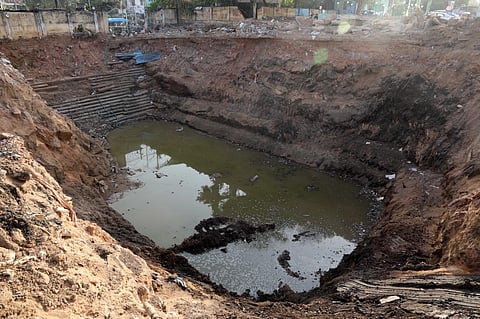

HYDERABAD: The Greater Hyderabad Municipal Corporation (GHMC) has adopted an unconventional approach to the restoration of heritage structures that involves their partial destruction. One such instance of this approach can be observed during the ongoing excavations at the Gudimalkapur flower market, where an early 19th-century stepwell has recently been unearthed.
For over a decade and a half, this stepwell lay buried beneath construction debris, a consequence of the flower market’s establishment in the area. Originally, this stepwell was an integral part of the Jham Singh Balaji Mahadev temple, situated across the road. The temple complex, named after Jham Singh, who constructed the temple, a horse stable, the stepwell, a mosque and other structures in the vicinity, holds historical significance. Jham Singh himself played a pivotal role in sourcing top-quality horses for the Nizam’s army and served as the commandant of the corps under the rule of Nawab Sikandar Jah and Asaf Jah III.
The stepwell’s degradation began in the early 2000s when homeless persons erected huts in the market area and started discarding trash there. In 2008, when the government established the flower market, construction debris was dumped into the well, sealing it shut.
“There were so many huge boulders from the Bhojagutta hillock located right next to it, which ended up in the well, in addition to construction debris. The cover of debris was about eight metres deep, after which the well started getting exposed. We used manual labourers and JCBs alternatively, taking utmost care not to disturb the steps, which had a distinct cut,” said a representative of the National Institute of Urban Management (NIUM), which identified the stepwell using the Munn maps prepared by Leonard Munn, the engineer who prepared them after the Musi floods in 1908.
These historic maps were overlaid onto Google Maps to pinpoint the precise location of the stepwell. However, archaeologists and heritage activists have expressed concerns regarding the excavation process.
“Whenever a heritage site is excavated, whatever is found belonging to the structure, they need to be numbered after being dug out or dismantled, and they need to be put together,” opined a senior official from the Telangana Heritage department.
During the excavation, pillars and broken steps were discovered amidst the rubble. Vishnu Vardhan Reddy, Assistant Engineer of GHMC Circle-2, revealed that each night, massive truckloads of debris are transported to the outskirts to create space for the next day’s excavated material.
Heritage activists have raised concerns about heritage sites being excavated and restored without the involvement of experts.
“The entire stretch from Golconda to Karwan and Charminar used to be the main route since the Qutub Shahi era. There are many heritage structures in that area and its restoration needs extreme care,” said P Anuradha Reddy, convener of INTACH, Hyderabad.
Prof Ramaswamy from Vaishnavi School of Architecture and Planning (VSAP), whose experts contributed to the identification of the buried stepwell, highlighted the necessity for a meticulous and time-consuming excavation process. He is also overseeing the re-documentation of the precinct and the development of the stepwell’s restoration plan. Prof Ramaswamy has served as an advisor to the Kerala State Art and Heritage Commission for the past 25 years.
To date, 27 feet of the 30-foot-deep well has been excavated, revealing 18 steps. The excavation has incurred an expenditure of `46 lakh. In collaboration with GHMC Khairatabad Zonal Commissioner and with inputs from VASP, NIUM is working to restore the Nakarkhana (drum house) and Dharamshala within the temple’s premises.